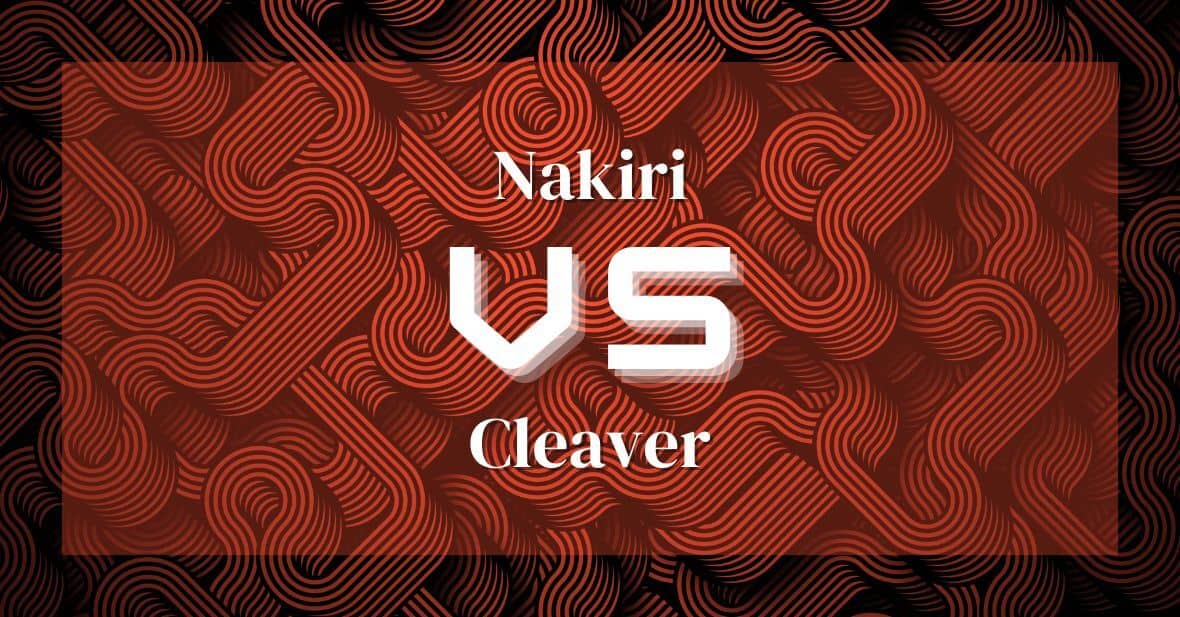Nakiri vs Cleaver: The Vegetable Cutting Conundrum
Hey there! Are you looking for the perfect kitchen knife? Then you’ve come to the right place.
The nakiri and cleaver are two of the most popular knives on the market, and they both have their advantages. In this article, we’ll take a close look at these two knives and compare them in terms of design & shape, blade thickness, uses & tasks, care & maintenance, and price & availability.
Get ready for an exciting journey into the world of kitchen knives!
Design and Shape
The design and shape of these two knives can make all the difference when it comes to slicing, dicing, and chopping.
The Nakiri knife is a flat-bladed vegetable cleaver that has a thin blade for effortless cutting techniques. Its wide surface area makes it perfect for evenly chopping leafy greens like kale or lettuce. It also has a sharp rectangular blade with an angled handle design that keeps your knuckles from hitting the cutting board as you chop.
On the other hand, the traditional cleaver is thicker and heavier than its counterpart. It’s designed with a curved blade which helps you apply more force when you’re slicing through tougher vegetables or meats. Despite being heavier, its curve allows users to rock on their cutting boards in order to achieve a finer chop than the straight edge of the Nakiri knife.
When it comes to choosing between these two knives, it really depends upon what you’re looking to cut!
Blade Thickness
You won’t have to worry about slicing through anything too thick with either of these knives, as both feature blades that are just the right thickness for their respective jobs. The Nakiri is a thin and lightweight knife designed for vegetables, while the Cleaver is a much thicker and heavier knife designed for bone-in meats.
When it comes to power comparison and edge retention, you’ll get optimal performance from each knife based on its blade thickness. When looking at the two side by side, it’s clear that there’s no mistaking one for the other. Nakiri blades are often between 2-4mm in thickness while Cleavers tend to be around 6-7 mm thick.
Choosing the right knife can make all the difference when preparing your meals – so let’s take a look at how these two compare:
- The extra weight of the cleaver gives it more power – perfect for heavy duty chopping tasks like breaking down a chicken or splitting larger vegetables.
- The thinner Nakiri blade allows you to slice paper thin vegetables easily without crushing them. It also has better edge retention than cleavers due to its thinner steel construction.
- Both knives offer excellent balance and control during use, allowing you to prepare food safely and quickly with minimal effort.
- Both styles have centuries of history behind them, making them trusted kitchen tools that will never go out of style!
Uses and Tasks
Both knives have unique uses and tasks that they excel at, from delicate slicing to tough chopping.
The nakiri is ideal for vegetable prep, with its thin blade able to make paper-thin slices with ease. Its edge retention is great for working through those veggies quickly without having to stop and sharpen the knife. The weight balance of the nakiri also makes it easy to use, allowing you to slice through vegetables in no time.
On the other hand, the cleaver is best used for heavier work like tough meats or bones. With its thicker blade, it can chop through these items more easily than a nakiri due to better weight balance and edge retention.
In conclusion, while both knives are great tools in their own right, each excels in its own way depending on what type of cutting task you need done!
Care and Maintenance
Keeping both knives sharp and well-maintained is key for efficient cutting, so it’s important to regularly hone and sharpen them to ensure they stay in top condition. It may seem like a hassle, but your nakiri and cleaver will thank you!
To keep the edges of your blades ultra-sharp, use one of the many sharpening techniques available. You can go old school with a traditional whetstone or take advantage of modern tools like electric sharpeners.
Cleaning your knives is also essential for proper care. Make sure to wash them by hand after each use; using soap and warm water should do the trick. Don’t forget to dry them off completely before storing away, otherwise you risk rust forming on the blades.
With these cleaning tips, you’ll be slicing and dicing with ease!
Price and Availability
Finding the perfect nakiri and cleaver for your kitchen doesn’t have to break the bank; there are plenty of affordable options available.
When it comes to price, one major difference between a nakiri and cleaver is weight. Generally speaking, cleavers are heavier than nakiris due to their thicker blade. If you’re looking for something with some heft that’ll get the job done quickly and effectively, a cleaver might be your best bet.
On the other hand, if you want something lightweight and more maneuverable in tight spaces, then a nakiri is probably better suited for you. In terms of edge retention, both knives retain their sharpness well but require regular honing as part of their maintenance routine – so be sure to keep up with that!
No matter what type of knife fits your needs best, rest assured that there are plenty of options available at varying prices that won’t break the bank.
Conclusion
You’ve heard of nakiri and cleavers, but which one should you choose? Well, they both have unique design elements and can be used for a variety of tasks.
But did you know that the average cleaver is twice as heavy as the average nakiri? That’s right – a cleaver can weigh up to 1.5 pounds, while a nakiri usually weighs about 0.75 pounds!
So if weight is an issue for you, then the nakiri might be the way to go. Just make sure you properly care for your knife and it’ll last for years to come!
Frequently Asked Questions
What Is The Difference Between A Nakiri And Cleaver?
Choosing the right knife for the job can be daunting, with so many options! But when it comes to slicing methods and cutting board selection, you really only have two choices: a nakiri or cleaver.
The biggest difference between these two tools is in their design and purpose. A nakiri is designed specifically for chopping vegetables, while a cleaver is meant for tougher tasks like meat and bones.
Both knives can effectively chop through produce, but the nakiri features an almost straight edge that makes slicing veggies easier than ever before. On the other hand, a cleaver has an even sharper angle that helps it cut through tougher materials without damaging them.
So if you’re looking for something to slice your tomatoes or celery, opt for a nakiri. If you need something more durable, then go with a cleaver!
What Is The Best Type Of Steel To Use For A Nakiri Or Cleaver?
When it comes to choosing the best type of steel for a nakiri or cleaver, blade hardness and edge retention should be taken into consideration. High carbon steel is a popular choice due to its ability to take on an incredibly sharp edge that can last through many uses.
However, stainless steel is often preferred as it’s easy to sharpen and isn’t prone to staining or rusting. Both types of steel offer excellent performance, so it really comes down to personal preference when deciding which one works best for you and your cooking needs!
Is A Nakiri Or Cleaver More Suitable For A Beginner?
If you’re just starting out with your culinary adventure, the knife you choose is important. Make sure it has stainless construction for durability and edge retention so you can keep slicing and dicing like a pro.
Both of these knives have their benefits. However, the cleaver has a thicker blade that makes it better for tough tasks like cutting through bones. On the other hand, the nakiri is thinner and more suited to finely chopping vegetables.
So, whether you feel like getting down and dirty with some meat or playing with your food, there’s an option for everyone!
How Should A Nakiri Or Cleaver Be Sharpened?
Sharpening your nakiri or cleaver is easier than you think! Start by finding a sharpening stone that meets your needs.
You can use different honing techniques such as flat honing, stropping, and edge beveling to get the perfect edge angle. Don’t forget to lubricate with oil for the best results.
With practice and patience, you’ll soon be able to sharpen like a pro! Don’t worry if it takes some time – even the pros have to work at it.
Have fun and enjoy yourself while working towards a perfectly sharpened blade!
How Long Does A Nakiri Or Cleaver Typically Last?
You won’t believe how long a knife can last!
Well, not forever of course, but if you get one with the right balance and edge retention, it can easily last you decades.
Whether it’s a nakiri or a cleaver, if you take good care of your blade and keep it sharpened correctly, you’ll be slicing veggies like a pro for years to come.
So go ahead and invest in that new kitchen essential – just make sure it has the right balance and edge retention for maximum longevity.
Additional Resources
19 Types of Kitchen Knives & Their Uses
Western Style Knives 101 | A Comprehensive Introduction to the Basics
The Art of the Slice: A Dive into Japanese Knife Types
What Is a Nakiri Knife Used For? Unlock the Secret to Flawless Vegetable Prep
Forging Culinary Excellence: The Best Steel For Kitchen Knives

